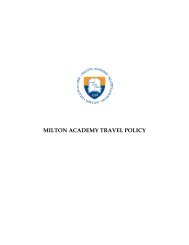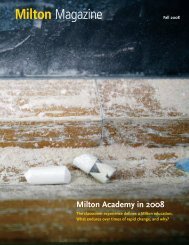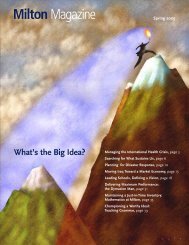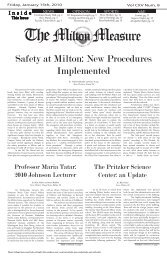In Washington, Jennie concentrateson LISC’s strategic directionOver its 25-year history, LISC has opened32 offices in cities across the country. Atits national center in Washington, D.C.,Jennie Bartlett ’00 focuses on the broadorganizational view of this communitydevelopment corporation.“For the last two and a half years my workhas involved supporting and strengtheningour local offices,” Jennie explains, “whichincludes brokering partnerships, workingwith them on developing their programplans, and managing internal processes tofacilitate an efficient and fluid relationshipbetween local operations and nationaloversight.”During her senior year at Trinity College(Hartford, Connecticut)—where shedesigned a major in international urbanstudies with a minor in architecture—Jennie took a community organizing class,through which she discovered LISC. Shewas drawn to the organization’s missionand its work in Hartford on homeownershipand community development.Working with LISC as an intern, shefocused her senior thesis on measuringthe impact of homeownership on the revitalizationof two Hartford neighborhoods.After graduation, she stayed with LISC atthe national level.Since 2005, Jennie has worked at a corporate-widestrategic plan. “Assessing the historyof the company over its 25 years ofexistence—determining what’s still relevant,how the environment has changed,how to add more value—has been anincredible experience,” she says. LISC’sinternal committee began with big questions:Can we achieve something locally wheneconomic forces are increasingly regional,national and international? Can communitydevelopment corporations (CDCs) accomplishsomething significant enough to affect thefundamentals of local life?The metrics of success (noted at the startof this article) measure the organization’ssuccess. “We saw how far we’d come, butwe needed to address whether we couldsustain a lasting impact, rather than justinjecting short-term support,” Jennie says.“We found that we can achieve a lastingimpact, but the question remains, ‘How dowe know these benefits will continue togrow?’”20 <strong>Milton</strong> Magazine
“We began as an affordable housing company,so we don’t want to move too farfrom our core competency, but we don’twant to limit ourselves either,” Jennieexplains. “You need more than affordablehousing to build and sustain a thrivingcommunity. You need to develop the entireneighborhood—environmental and childcaredevelopment, business and education.”An example of this comprehensivedevelopment is in LISC’s affiliation withthe National Football League GrassrootsProgram, which has donated $2.5 millionso that 16 cities around the country—from Seattle, Washington, to Jacksonville,Florida, to Brookline, Massachusetts—canbuild or improve upon existing communityfootball fields.“LISC is best at organizing and buildingpartnerships at the local level,” Jennie says,“and we bring to the table our ability toprovide national loan capital to help fundlocal initiatives. Choosing 11 pilot sites forthe new sustainable plan was complicated,but we worked hard to choose the localoffices that were already engaged in comprehensivecommunity development andcould successfully achieve the sustainablecommunities goals in five years. One ofthe greatest challenges of initiating thestrategic plan is communicating its messageand its vision, both nationally andlocally. I am excited to be a part of thisongoing process.”Jennie’s path to LISC started with <strong>Milton</strong>.“I left <strong>Milton</strong> with the idea that I wascharged with being an active, contributingmember of society. <strong>Milton</strong> really instilled asense of obligation in me, as well as asense of capability.“Our work at LISC demands fluency in arange of components—real estate, communitydevelopment, finance, partnershipbuilding, strategic management. I love thatthis work combines so many fields ofstudy and areas of interest. LISC hasextremely high intellectual capital; similarto my experience at <strong>Milton</strong>, the companybrings together smart, diverse, sociallyaware people who are dedicated to a mission.Addressing, on a daily basis, the economicand social dilemma of distressedurban and rural communities has been aprofoundly grounding and educationalexperience.”Erin HoodletJennie Bartlett ’00From these discussions emerged five programobjectives that, taken together, contributeto comprehensive communityhealth and sustainability: expanding capitalinvestment in housing and other realestate; increasing family income andwealth; stimulating economic activity—connecting to regional economy; improvingaccess to quality education; andsupporting healthy environments andlifestyles.“THE ARC”: Brand-new community facility in Northeast Washington, D.C., that includes a full theatre stadium,dance studio, music and arts rooms, and rental space for CDCs (among other things); supported byWashington, D.C., LISC.21 <strong>Milton</strong> Magazine
















